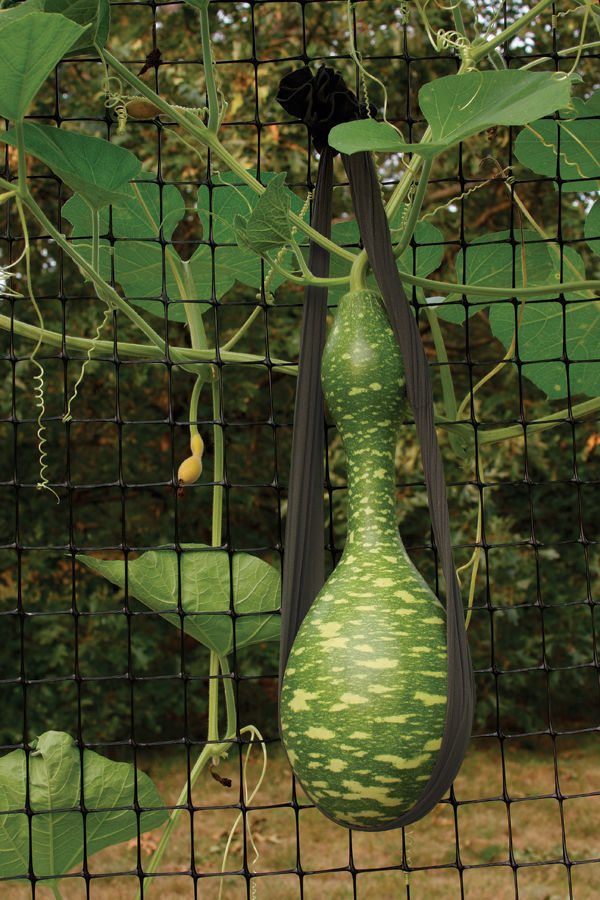Learn How to Trellis Your Sprawling Veggies
Short on room? Try growing these vines up, not out

Cucumbers, winter and summer squash, and melons are infamous for sprawling beyond their allotted space. Attempts to contain the relentless growth of the Cucurbitaceae family by simply moving growing tips away from neighboring plants tend to end the same way: with the gardener giving up and admitting defeat. These vigorous vines can be persuaded, however, to grow up—instead of out—thanks to their tendrils, which fasten onto anything in their path. Climbing sprawlers are often healthier, too, because free movement of air through their leaves helps prevent mildew and other fungal diseases. A sturdy trellis and some square garden netting are all you need to get started. After that, it’s just a matter of guiding the vines to grow vertically.
Build a trellis strong enough to handle a squash
To make a suitable trellis, I begin by driving 8-foot-long 2×2 posts 2 feet into the ground and spacing my posts 8 feet apart. Because I also use 2x2s for other crops (including tomatoes, peas, and beans), I bought a long, 2-inch-diameter augur bit for my battery-powered electric drill. This drill attachment easily cuts nice deep holes into the soil, which the posts fit into neatly. Hammering loose earth around the edges of the holes with a short piece of 2×4 holds the posts steady.
I then hammer two nails into the top of each post at an angle, forming a V, and set a 10-foot length of ½-inch-diameter concrete rebar across the top. Where the pieces of rebar overlap at each post, I fasten them together with black plastic cable ties. This, and their sheer weight, holds them firmly in place. Hanging large-mesh netting from the rebar and the posts is the final step. Plastic cable ties work for this task as well.
If the strength of this trellis seems like overkill, remember that cucurbit fruit are heavy and that a stiff wind blowing against the vertical vines exerts a lot of force. At the end of the growing season, you can detach the vines from the netting and use wire cutters to snip all the cable ties. Gather the netting, posts, and rebar, and store them out of the way to use the following year.
Train your vines up the netting
Many growers adhere to the old practice of setting two or three squash plants on a small mound, which theoretically improves drainage and allows the sun to warm the soil sooner. I dislike this method, however, because, even with a drip-irrigation system, I find that the mounded soil dries out too quickly for the plants’ shallow root systems. I prefer to set trellised plants 18 to 24 inches apart, in a straight line, on level ground that I amend with compost or rotted manure.
While peas and beans naturally climb upward, you’ll need to show your squash and melon vines the way. You can use soft twine or plastic plant tape to attach their stems to the trellis netting, but I favor tomato clips, which attach to the netting and gently encircle delicate stems. Check the plants every three to four days, and steer any errant vines in the right direction, securing them in place. Watchful maintenance is necessary, or your sprawlers will quickly get away from you.
If your plants grow too vigorously, you can use sharp scissors or pruners to trim off about 6 inches of the growing tips as well as several leaves. Removing the growing tips limits growth, and cleanly snipping some leaves allows for better air circulation through the plant. Don’t overdo it, however, and don’t prune whole stems—the wound will “bleed” and invite pests.
It’s common for the fruit of cucurbits to require support while growing up a trellis. Summer squash are relatively small and firmly attached to the plant, but melons and gourds are both heavier and less firmly attached. You can support them with a sling made of cheesecloth or T-shirt cloth that’s tied to the trellis netting, but I find that cut-off panty hose works best of all.
It’s best to harvest zucchini, cucumbers, and other summer squash frequently—every one to two days; otherwise, you’ll discover small “baseball bats” hanging from the trellis. All of these squash are tastiest when small anyway, so frequent picking is a benefit for you and the plant.

Veggie varieties perfect for trellising
Home gardeners and commercial growers have welcomed dozens of new cucurbit varieties in the past several years. The compact/bush varieties need little or no support and stay within a small space, while small-fruited types produce “baby” fruit that place less weight on climbing stems.
Compact and bush varieties
• ‘Autumn Glow’ winter squash is a butternut that stays within a 4-foot-square space.
• ‘Table Queen’ acorn squash and ‘Cornell’s Bush Delicata’ squash are bush types that spread only 2 to 3 feet and produce well.
• ‘Cream of the Crop’ squash has creamy white flesh and disease resistance.
• ‘Dwarf Summer Crookneck’ squash produces prolific yellow-to-orange warted fruit.
Small-fruited varieties
• ‘Baby Bear’ pumpkin is about half the size of normal pie pumpkins and produces well.
• ‘Jack Be Little’ pumpkin is 4 inches across, perfect for decorating.
—Peter Garnham is a master gardener and commercial grower of vegetables and herbs who farms on eastern Long Island, New York.
Photos: Brittany Leandra; courtesy of National Garden Bureau, Inc.; courtesy of Drilnoth/commons.wikimedia.org; Ann E. Stratton. Illustration: Martha Garstang Hill








Comments
Log in or create an account to post a comment.
Sign up Log in